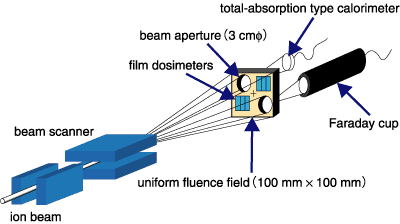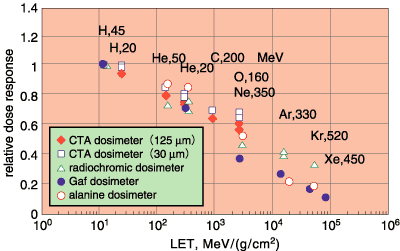The range of interesting materials studied in radiation application research using ion beams have recently been extended from semiconductors and inorganic materials to organic materials including living organisms. In studies on organic materials, it is necessary to develop an accurate measurement technique for the absorbed dose in the materials irradiated with ion beams, since the absorbed dose is a common measure which is indispensable in the evaluation of irradiation effects. Accurate dosimetry, however, is difficult under the usual beam conditions of ion accelerators, because the radiation field is quite small, and also local intensity in the field is generally non-uniform and unstable.
To eliminate these problems in absorbed dose calibration, we prepared a uniform radiation field of large area using two-dimensional beam scanning, and designed a simultaneous measurement system of particle fluence and energy fluence in the ion radiation fields. The ionization chamber cannot be used for such dose calibration in the very high dose-rate field. The absorbed dose can be calibrated by energy fluence when the depth distribution of relative dose in the irradiated materials is given. The distribution was measured with simultaneous irradiation of a stack of plastic film dosimeters and the fluence measurement system (Fig. 5-20).
As the result of this development, we achieved an uncertainty of ± 2% in particle fluence measurement and an overall uncertainty of ± 5% in dose calibration, including the uncertainty in the film dosimetry. We also clarified LET (linear energy transfer) dependence of dose responses of various dosimeters in a wide range of LET (Fig. 5-21). These works will contribute to ion beam applications to organic materials, of which the irradiation effects can be accurately evaluated and compared with those induced by gamma-rays and electron beams. |

